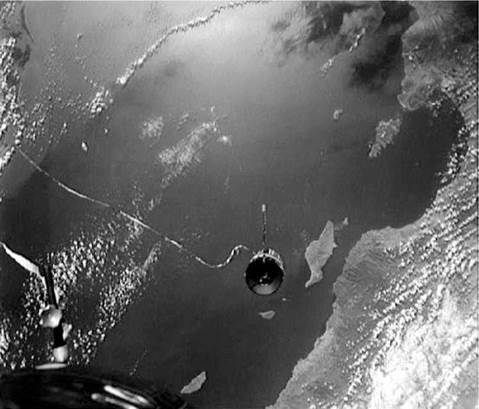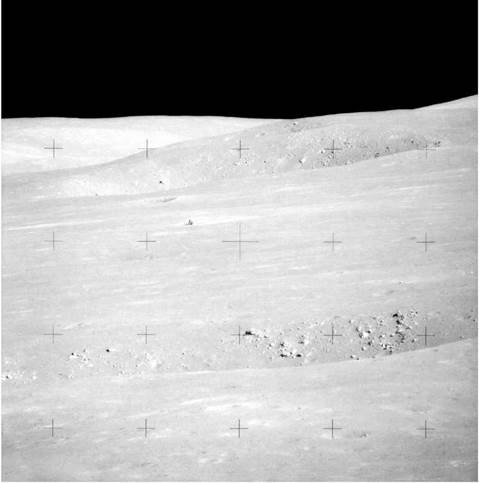 2009-030A May 27, 2009
2009-030A May 27, 2009
Pad 1, Site 5, Baikonur Cosmodrome, Republic of
Kazakhstan
December 1, 2009
57 km from the town of Arkalyk, Republic of Kazakhstan
Soyuz-FG (serial number Ю15000-030),
Soyuz TMA (serial number 225)
187 da 20 h 41 min 38 s Parus (“Sail”)
ISS resident crew (ISS-20/21), transport (19S) to establish six-person crew capability
Flight crew
ROMANENKO, Roman Yuriyevich, 37, Russian Federation Air Force, RSA Soyuz TMA commander, ISS flight engineer
DE WINNE, Frank, 48, Belgian Air Force, ESA (Belgian), Soyuz/ISS flight
engineer, second mission
Previous mission’. Soyuz TMA-1 (2002)
THIRSK, Robert Brent, 55, civilian (Canadian), CSA Soyuz/ISS flight engineer, second mission Previous mission: STS-78 (1996)
Flight log
It was with this mission that ISS crewing became a little more complicated to keep track of. On March 29, 2009, Soyuz TM-15 and its three crew members, representing Europe (Belgium), Russia, and Canada, docked to the station after a nominal 2-day flight from Baikonur. Already on board the station was the three ISS-19 crew members, representing Russia, Japan, and the U. S., marking a truly international complement. Unlike previous resident crew arrivals, the ISS-19 crew would not immediately return to Earth, but would remain on board as part of the first six-person resident crew, now designated ISS-20.
The TMA-15 flight was the first complete three-person ISS resident crew complement launched on a Russian launch vehicle and spacecraft since ISS-1 in 2000. The arrival of TMA-15 instigated the change in crew exchange protocol and represented a significant increase in resident crew time for science aboard the station. For the first time, a representative from each of the main ISS partners was part of the main crew.
|
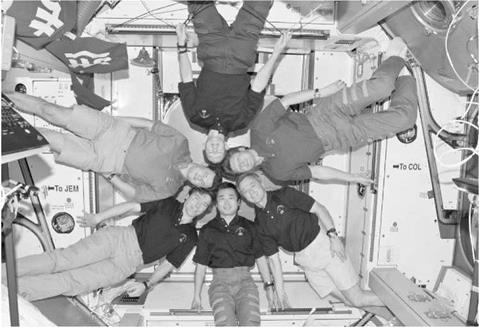
The six-person Expedition 20 crew in “starburst” formation. Clockwise from right are Padalka, Thirsk, Wakata, Barratt, Romanenko, and De Winne.
|
At the time of docking with the station, Padalka, Barratt, and Wakata were in residence as ISS-19, and once the hatches were opened, the TMA-15 crew joined them as flight engineers and the six became ISS-20. On July 17, U. S. astronaut Kopra arrived on STS-127 (2J/A) to take over from JAXA astronaut Wakata, who returned at the end of that Shuttle mission. Barely six weeks later on August 31, Nicole Stott replaced Kopra during the STS-128 (17A) activities. Both Kopra and Stott served as flight engineers for the crew of ISS-20 and Stott remained as flight engineer for ISS-21/22 until she came home on STS-129 in November, shortly before the return of the core TMA-15 crew. These were the final Shuttle – delivered crew members. All station resident crew members for the foreseeable future would now be delivered by Russian Soyuz.
The ISS-20 experiment program continued the work conducted during ISS-19. With the Japanese and European laboratories recently installed, the opportunity for broadening the research had increased significantly. By the time this mission flew, most of the station hardware had been delivered by the Shuttle and reflected a change that was taking place. The ISS was evolving from an assembly site to a fully functioning scientific research facility. The Russians noted that during ISS-21/22, there would be 304 sessions on 47 experiments, while NASA reported that over 150 operating experiments would be completed under the station’s new role as a U. S. National Laboratory.
Two new crew members for ISS-21/22 arrived aboard TMA-16 on October 2, together with space flight participant Guy Laliberte. He would return with the TMA-14 pair (Padalka and Barratt) on October 11, leaving behind the ISS-21 expedition which would last just six weeks until the TMA-15 crew came home. Officially, ISS-21 began on October 9 and lasted until November 25. During ISS-21 there were no EYAs, but the crew did see the arrival of Progress M-03M and the release of the Japanese HTV-1 with about 725 kg of unwanted equipment and rubbish for burn-up in the atmosphere. On November 12, Mini Research Module-2 (which was delivered by a modified Progress M vehicle) docked with the zenith (upper) port of Zvezda. With all this activity, the crew was certainly not struggling to keep themselves occupied.
STS-129 departed on November 25 carrying Stott home and, just five days later, the TMA-15 trio departed the station for a landing in the early hours of December 1 after a historic and highly successful mission. Following these departures and for the first time since July 2006, the station was down to a skeleton crew of just two until the next Soyuz launched just prior to Christmas 2010.
In a flight of 188 days, the TMA-15 crew had spent all but two of them on the space station. Of these, 133 were as members of the ISS-20 expedition and just 47 days as ISS-21. De Winne became the first European station commander (ISS-20) and Thirsk the first resident Canadian crew member. Future crewing would feature a rota of U. S.-Russian crew members and an allocation of Soyuz seats for Canadian, Japanese, and ESA crew members. NASA reported that the new expedition actually began with the undocking of the outgoing crew on the TMA (though the formal change of command actually took place a few days earlier). In fact, as the crew exchanged command, the outgoing crew became known as the “non-prime crew” for their final few days prior to coming home, while their replacements became the “prime crew”, which just seemed to add confusion to those following the formal trail of command and assignment.
Operating a rotating six-person crew and only flying on the Soyuz TMA spacecraft meant that there would be no free seats for fare-paying passengers. Unless separate funds for a complete Soyuz vehicle could be found by those who arranged SFP/tourist flights, it would be very hard for anyone other than a professional astronaut or cosmonaut to fulfill their dream of flying in space for some considerable time.
Milestones
267th manned space flight 108th Russian manned space flight 101st manned Soyuz flight 15th manned Soyuz TMA mission 19th ISS Soyuz mission (19S)
20/21 st ISS resident crew
Romanenko is the son of cosmonaut Yuri Romanenko (selected 1970), who flew on STS-26 (1977), Soyuz 38 (1980), and Soyuz TM2 (1987)
Final Shuttle-launched ISS crew members (Kopra and Stott)

Flight crew
POLANSKY, Mark Lewis, 53, civilian, NASA commander, third mission Previous missions-. STS-98 (2000), STS-116 (2006)
HURLEY, Douglas Gerald, 42, USMC, NASA pilot WOLF, David Alan, 52, civilian, NASA mission specialist 1, fourth mission Previous missions-. STS-58 (1993), STS-86/89/Mir (1997), STS-112 (2002) CASSIDY, Christopher John, 39, USN, NASA mission specialist 2 PAYETTE, Julie, 45, CSA, (Canadian) mission specialist 3, second mission Previous mission-. STS-96 (1999)
MARSHBURN, Thomas Henry, 48, civilian, NASA mission specialist 4 ISS resident crew exchange
KOPRA, Timothy Lennart, 45, U. S. Army, NASA mission specialist 5,
ISS flight engineer (up only)
WAKATA, Koichi, 45, Japan, JAXA mission specialist 5, ISS flight engineer
(down only), third mission
Previous missions-. STS-72 (1996), STS-92 (2000)
Flight log
The 29th Shuttle mission to ISS featured a range of robotic operations, most of which focused around the delivery of elements of the Japanese Kibo laboratory module. In addition, U. S. NASA astronaut Tim Kopra was the latest resident crew member to arrive via the Shuttle. He replaced outgoing Japanese (JAXA) astronaut Koichi Wakata, who had been on the station since March.
|
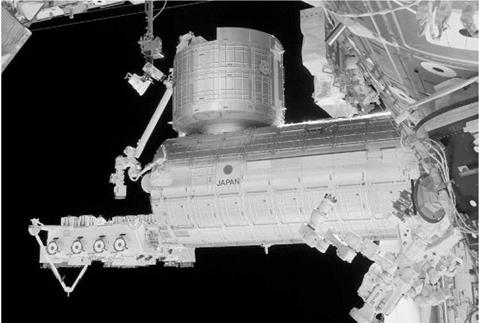
Japanese Kibo Experiment Module and Exposed Facility.
|
Final mission preparations began with Endeavour being taken into the OPF on December 13, 2008. The orbiter was then moved across to the VAB on April 10, 2009, where it was mated with the twin SRB and ET before being rolled out to Pad 39B on April 17. This preparation was for its role as a “rescue” vehicle for the forthcoming STS-125 Hubble Service Mission. In the event, this requirement was not called upon after the STS-125 mission proceeded smoothly. On May 31, the STS-127 stack was relocated across to Pad 39A for a planned launch on June 13.
On June 12, a hydrogen leak at the Ground Umbilical Carrier Plate (GUCP) during tanking caused the June 13 attempt to be scrubbed. The seal on the 17 in. (43.18 cm) disconnect valve was replaced and the launch rescheduled to June 17. This attempt was also scrubbed in the early hours of the planned launch day when a similar type of hydrogen gas leak occurred at the GUCP. Troubleshooting of the vent valve took an hour and when it became clear that the problem could not be easily resolved in the current launch window, the launch was eventually rescheduled for July 11. This next attempt was also postponed 24 hours to allow technicians more time to evaluate lightning strikes at the launchpad, which had occurred during a thunderstorm on July 10. It was determined from sensors that 11 lightning strikes had occurred within 0.35 miles (0.56 km) of the pad, which was inside the pad threshold. Launch was rescheduled again for July 12, but once again was scrubbed, this time at T — 11 minutes before scheduled launch time due to weather concerns near the Shuttle Landing Facility (SLF) that violated rules for landing. A fifth launch attempt on July 13 resulted in another postponement due to lightning and thunderstorms within the 20 nautical mile circle around the pad. The sixth attempt, rescheduled for July 15, finally occurred without incident.
During the standard two-day flight to the space station, the crew completed the customary survey of Endeavour’s thermal protection system using the RMS boom assembly. The pressure suits to be used on the EYAs were also prepared and checked. The now regular backflip maneuver was completed just prior to docking. Shortly after entering the space station, Kopra joined the ISS resident crew and Wakata transferred to the Shuttle crew, ending his formal ISS crew residency after 122 days.
There were five EYAs conducted as part of the STS-127 mission, totaling 30 hours 30 minutes. Four astronauts (including Kopra) participated in the excursions, teaming up in pairs. Marshburn logged 18 hours 59 minutes on three EVAs, Wolf logged 18 hours 24 minutes on his three space walks, and Cassidy amassed 18 hours 5 minutes on his three excursions. Kopra logged 5 hours 32 minutes on his single EVA as part of the STS-127 program.
During the first EVA (July 18, 5h 32 min), Wolf and Kopra managed to complete all of their primary tasks. These included preparations for the berthing mechanism on Kibo and on the Japanese Exposed Facility, which was transferred to the station. They also deployed an unmanned cargo carrier attachment system on the P3 truss, which had failed to unfurl properly during STS-119 the previous March.
Robotic arm operations continued during and in between the space walks, supporting and supplementing EVA activities. Following the first EVA, the Shuttle RMS and the station robotic arm were used to latch the JEF to Kibo’s laboratory. The installation was viewed by the Kibo RMS. Further robotic activities included the installation of the Integrated Cargo Carrier-Vertical Light Deployable (ICC-VLD) cargo pallet. This was located on the port side of the station’s Mobile Base System (MBS).
During the second EVA (July 20, 6 h 53 min), Wolf and Marshburn removed a Ku-band space-to-ground antenna, a pump module, and a liner drive unit from the Integrated Cargo Carrier. The two astronauts then attached these items to a storage platform on the P3 truss. Next, Marshburn mounted a grapple bar onto an ammonia tank assembly, which the STS-128 crew would later move with the help of the RMS. He also attached two external power connector insulation sleeves to the Station-to-Shuttle Power Transfer System. The planned installation of a video camera was deferred from this EVA to a later excursion. This EVA had taken place on the 40th anniversary of the famous first lunar surface activity (moonwalk) conducted by Neil Armstrong and Buzz Aldrin during the Apollo 11 mission. Both the station and Shuttle crews honored the legacy of that historic mission and event.
Following the second EVA, Polansky and Payette used the Shuttle RMS to pass the Japanese Logistics Module’s Exposed Facility from Endeavour to Canadarm2 on the station. Canadarm 2 was operated by Hurley and Wakata, who then attached it to the Kibo laboratory. Astronauts Hurley and Payette then used the station’s robotic arm to move the ICC and to secure the batteries in preparation for the P6 truss battery swap.
The third EVA (July 22, 5h 59 min) saw Wolf and Cassidy remove insulation covers from the Kibo Laboratory, as well as preparing the JES payloads for transport to the Exposed Facility the following day. Two batteries were also installed but the EVA was curtailed early when CO levels in Cassidy’s suit were found to have increased more than expected. The next day, several astronauts took turns to use the Japanese RMS for the first time to move equipment from a Japanese Payload Carrier to the Exposed Facility on the exterior of Kibo. The initial movement of this new arm was faster than expected, so the arm was transitioned to a Slower Manual Mode. The three installed experiments on the facility were the Monitor of All-sky X-ray Image (MAXI), the Inter-orbit Communications System and, the Space Environment Data Acquisition Equipment-Attached Payload.
During the fourth EVA (July 24, 7h 12 min), Cassidy and Marshburn installed the remaining four batteries on the P6 truss. Four of the older batteries were stored on the ICC for the return to Earth. The completion of robotic work would include the transfer of the ICC back to Endeavour’s payload bay by means of the station and Shuttle robotic systems.
The fifth and final EVA (July 27, 4h 54 min) saw Marshburn and Cassidy install video cameras on the front and back of the Japanese Exposed Facility to assist with the forthcoming rendezvous and berthing of the H-II Transfer Vehicle scheduled to arrive that coming September. The EVA astronauts also secured multilayered insulation around the Special Purpose Dexterous Manipulator (Dextre), split out power channels for the station’s CMGs (Control Moment Gyros), tied down cables, and installed handrails and a portable foot restraint to aid future space walks.
Alongside the five EVAs and associated robotic activities, work continued inside the station. Crew members and flight controllers spent their time troubleshooting the failure of the Waste and Hygiene Compartment (the toilet in the Destiny Laboratory Module). The Carbon Dioxide Removal Assembly on the station also tripped a circuit breaker on July 28 and the ground team switched to manual operation of the backup heater.
Wakata had logged 133 days on the station by the time Endeavour undocked on July 28. After 10 days 23 hours 41 minutes of joint operations, the undocking was followed by the traditional fly-around of the complex, controlled by pilot Hurley, before moving away from the station.
After separation from the station, work was not over for the crew. In addition to a checkout of the Flight Control System and maneuvering engines and stowing of gear, the crew deployed two pairs of small satellites from the Endeavour payload bay prior to the landing at Kennedy Space Center. These were the Dual RF Astrodynamic GPS Orbital Navigation Satellite (DRAGONSat) and the dual Atmospheric Neutral Density Equipment 2 (ANDE-2) satellite. The subsatellites were designed and built by students at the University of Texas in Austin and the Texas A&M University in College stations. The ANDE-2 microsatellites would
measure the density and composition of the rarefied atmosphere 200 miles (321.8 km) above the surface of Earth. DRAGONSat de-orbited on March 17, 2010, while the pair of ANDE satellites reentered the atmosphere on March 29 and August 18, 2010, respectively.
Milestones
268th manned space flight 157th U. S. manned space flight 127th Shuttle mission 23 rd Endeavour mission 10th Endeavour ISS mission 29th Shuttle ISS mission 2nd Shuttle mission to feature five space walks

Flight crew
STURCKOW, Frederick Wilford, 48, USMC, NASA commander, fourth mission
Previous missions: STS-88 (1998), STS-105 (2001), STS-117 (2007)
FORD, Kevin Anthony, 49, USAF (Retd.), NASA pilot
FORRESTER, Patrick Graham, 52, USAF (Retd.), NASA mission specialist 1,
third mission
Previous missions: STS-105 (2001), STS-117 (2007)
HERNANDEZ, Jose Moreno, 47, civilian, mission specialist 2/ffight engineer OLIVAS, John Daniel, 44, civilian, NASA mission specialist 3, second mission Previous mission: STS-117 (2007)
FUGLESANG, Arne Christer, 52, civilian (Swedish), ESA mission specialist 4, second mission
Previous mission: STS-116 (2006) ISS resident crew exchange
STOTT, Nicole Maria Passano, 46, civilian, NASA mission specialist 5, ISS-20
flight engineer (up only)
KOPRA, Timothy Lennart, 45, U. S.A., NASA mission specialist 5, ISS-20 flight engineer (down only)
Flight log
According to reports from NASA, this was the mission which marked the beginning of the station’s transition from assembly to a continuous scientific research facility. The Leonardo MPLM was packed with supplies, stores, and new equipment to continue outfitting of the station. It was also the final Shuttle
|
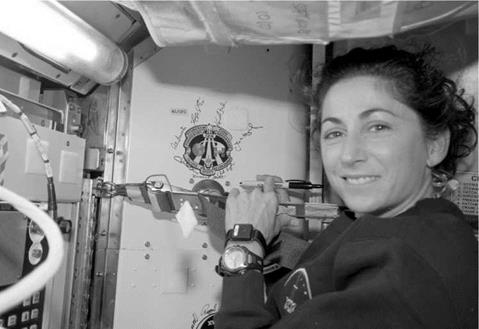
The final Shuttle-delivered ISS resident crew member Nicole Stott in the Quest Airlock.
|
mission to deliver a new resident station crew member. Nicolle Stott (NASA) would replace Tim Kopra after his 58 days aboard the orbital complex.
Preparations for the mission saw orbiter Discovery return to the OPF on March 28, 2009. It was rolled over to the VAB on July 26 for mating with the SRB and ET, with rollout to the pad occurring on August 4. The original August 25 launch attempt was scrubbed due to adverse weather conditions and the second attempt on August 26 was also postponed (during the refueling of the ET) following indications that a valve on the Main Propulsion System (MPS) had failed to perform as expected. A third attempt (August 27) was also postponed 24 hours to allow engineers more time to resolve an issue with a valve in the vehicle’s propulsion system. The fourth launch attempt, on August 28, was accomplished successfully and completed without any major issues.
Prior to docking with the station, the obligatory inspection routines were completed to check the integrity of the heat shield. Following analysis of the imagery on the ground, the thermal protection system was deemed secure for entry and landing.
After the docking and opening of internal hatches, Kopra became part of the Shuttle crew while Stott transferred to the resident crew. Kopra had logged 45 days on board the station as an official resident crew member. The crew also prepared and moved the OBSS across to the station’s Canadarm2 to create additional room for maneuvering the Leonardo MPLM from the cargo bay to the Harmony
Node on station the following day. The rest of the day was spent preparing the pressurized cargo module for the transfer of supplies and logistics, an operation which would take the next six days to complete. Olivas, Hernandez, and Stott also prepared the tools for the planned EVAs, placing them in the station’s Quest airlock.
Three EVAs were completed on this mission, focused upon replacing experiments outside the ESA Columbus Laboratory and installing a new ammonia storage tank. Nicole Stott participated in the first EVA (September 1, 6h 35 min) with Olivas, during which they removed the depleted ammonia tank on the PI (Port 1) segment of the truss. The ammonia in these tanks is used to cool the station and expel the heat generated by the resident crew and onboard systems.
The next task was to retrieve two science experiments, EUTEF and MISSE-6, from the ESA Columbus Laboratory. The European Technology Exposure Facility (EuTEF) held a number of different experiments which collected data on the space environment. The sixth Materials International Space Station Experiment (MISSE-6) was housed in two suitcase-sized containers and was used to evaluate the effects of the environment on various materials and coating samples. Olivas reported seeing what he described as MMOD (micrometeoroid and orbital debris) “hits” on a station toolbox and the Quest airlock. He took photos of the area for later evaluation on the ground to determine whether the damage was a cause for concern, although hits for MMOD are not unexpected. For 30 minutes during the EVA, MCC Houston did not have communication with either the station or the Shuttle due to bad weather in Guam that effected the TDRSS reception.
On the second EVA (September 3, 6h 39 min), Olivas and Fuglesang installed a new ammonia tank on the PI truss segment and bolted the removed empty assembly into the orbiter’s payload bay. Protective lens covers were installed on the station RMS cameras, which would shield them from contamination when the arm was used to dock the Japanese H-ll Transfer Module later that month (September). The two astronauts also installed a portable foot restraint on the station’s truss system for use during upcoming missions. The astronauts discovered that the heater cables on the exterior of PMA-3 appeared to be in an incorrect configuration to extend sufficiently for planned relocation and as a result this task had to be deferred.
The final EVA of this mission (September 5, 7h lmin) saw Olivas and Fuglesang set up a payload attachment system on the station truss, which would be activated on the next mission. In addition, they replaced a rate gyro assembly and remote power control module, installed two GPS antennas, and removed a slide wire on the Unity Node. The connection of two avionics cables could not be completed on this EVA and had to be rescheduled for a future excursion. These would eventually be connected to Tranquility (Node 3), the final main module that would be delivered to the U. S. segment. The cables were wrapped in insulation, but it was found that one of the connectors on one of the cables would not mate. At the end of the EVA Fuglesang’s helmet-mounted video camera and headlight system became detached, so Olivas helped Fuglesang to connect a tether to the system and plans were devised to inspect its latches after they were back inside the spacecraft.
In total, the three space walks accumulated 20 hours 15 minutes. Olivas logged 20 hours 15 minutes in three EVAs, Fuglesang 13 hours 40 minutes on two space walks, and Stott 6 hours 35 minutes on her single venture outside.
On September 2, the Shuttle and station crews transferred the Fluids Integrated Rack, Materials Science Research Rack-1, and Minus Eighty-Degree Laboratory Freezer-2 from Leonardo and installed them in the U. S. Laboratory Destiny. In addition, ISS resident crew member Mike Barrett installed and outfitted the third and fourth planned NASA crew quarters facihties. Inside the station, crew members replaced one of the 16 common berthing mechanism bolts used to secure the Leonardo cargo carrier to the station, as it had not operated correctly earlier in the mission. An old oxygen generation assembly water filter was also opened and inspected. It had been replaced prior to the arrival of the Shuttle. It was found that the filter was 70-80% blocked and the inspection increased confidence that the replacement filter had returned the system to full functionality.
During the docked phase, NASA reported that approximately 7.5 tons of equipment and supplies had been transferred out of Leonardo and 2,4001b (1,088.64 kg) of discards and experiment results placed back inside the module for return to Earth, all under the supervision of loadmaster Fuglesang. The Shuttle middeck held a further 8,8601b (4,018.89 kg) of returned items. One of these was the Disney astronaut character Buzz Lightyear from the Toy Story films. This was part of the NASA “Toys in Space” project designed to encourage students to pursue studies in science, technology, engineering, and mathematics (STEM). The Disney “Space Ranger” had logged 15 months on board the station. MPLM Leonardo was returned to the payload bay on September 7.
Discovery undocked on September 8 after 8 days 18 hours 32 minutes of joint operations. Following the normal fly-around of the station and pre-landing checks, the orbiter was prepared for landing. Weather concerns prevented a return to the Cape on September 10 and again the next day. The landing was completed on Runway 22 at Edwards AFB in California. On his mission, Kopra had logged a total of 58 days in flight, of which 8 were aboard the space station as a Shuttle crew member and 5 were spent aboard the Shuttle either flying to or coming home from the station. As well as the normal postflight activities for the “human” space crew, the “other” space hero of the mission—Buzz Lightyear—was celebrated with a tickertape parade alongside his space station crew mates and Apollo 11 astronaut Buzz Aldrin at Walt Disney World in Florida on October 2, 2009.
Milestones
269th manned space flight 158th U. S. manned spaceflight 128th Shuttle mission 37th Discovery mission 11th Discovery ISS mission 30th ISS Shuttle assembly mission











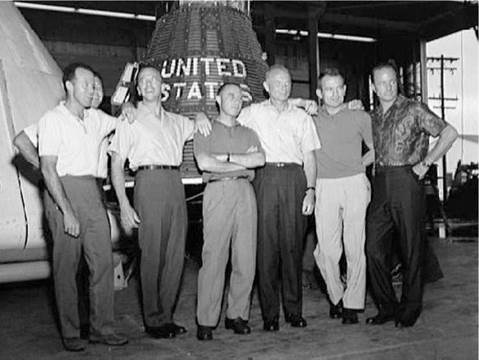
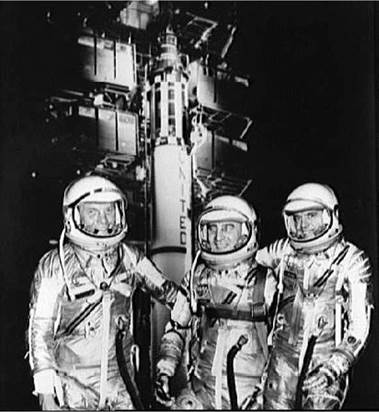
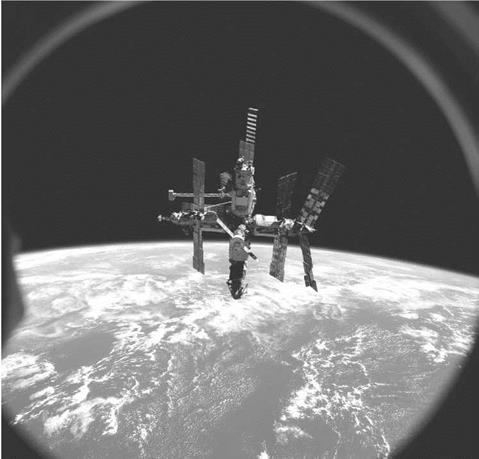
 2009-030A May 27, 2009
2009-030A May 27, 2009






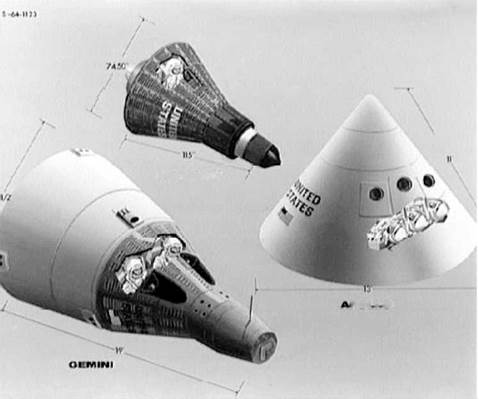 MtriCUN*
MtriCUN*